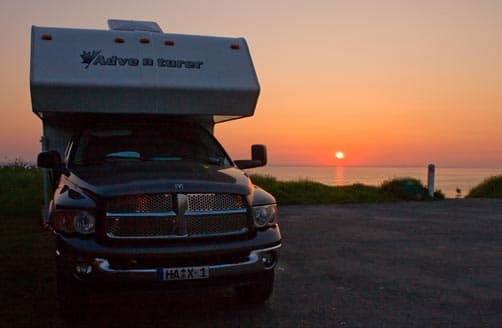Call it boondocking. Call it dry camping. We call it fun, free, and a major reason why we love truck campers! Here’s boondocking expert Bob Difley on how it’s done.

In truck camping circles, the term boondocking is thrown around a lot. We remember the first time we heard the term boondocking and how enchanted we were with the concept. Camping where you want – for free? Yes please!
When enchantment hits reality, it’s not quite that simple. To help newbies navigate the boondocking concept, we contacted renown RV boondocking expert, Bob Difley. Bob is the author of several e-books on boondocking and regularly writes boondocking articles for RV.net’s blog, Trailer Life Magazine, and Motorhome Magazine. Bob even taught boondocking classes for ten years at Life On Wheels RV conferences. If anyone is an expert on helping folks learn to boondock, it Bob.
Boondocking 101: Water, Tanks, Power, and Propane
by Bob Difley
Can you imagine someone with a forty-foot diesel pusher motorhome or fifth wheel boondocking with only Mother Nature and coyotes as neighbors? No? How about someone with a truck camper? Of course! That’s what they’re for.
Truck manufacturers pride themselves on their vehicles’ abilities to tame rough terrain. Camper manufacturers also make their mini-homes complete with full capabilities for camping off road and off-the-grid. No hook-ups needed, thank you.
If you haven’t yet struck out on a rutted old logging road or sandy desert track, sooner or later that urge will come. After you wake up that first morning with the sun just about to peek over the eastern horizon and no other rigs or humans in sight, you’ll be hooked. This article is an introduction on how to prepare yourself and your rig for a boondocking adventure.
What is Boondocking?
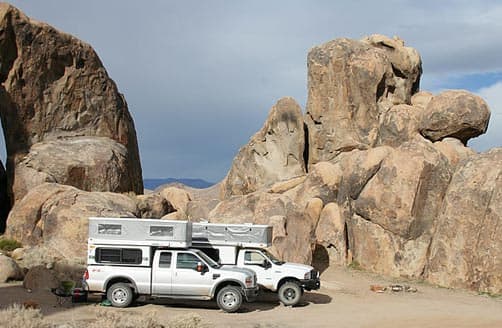
The word “bundok” (boondock) comes from Tagalog, the language of the Philippine Islands, and means “mountain”. Definitions include, “rural country; the backwoods” and, “place remote from civilization”. General usage of the term boondocking in the RV world is often used inaccurately to describe the function of camping without hook-ups, not where you do it.
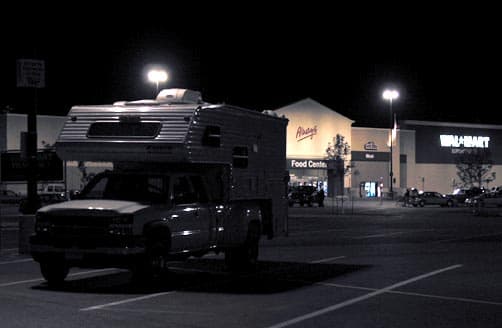
Dry camping, a more accurate term, would include camping in primitive campgrounds (like the forest service), Walmart parking lots, RV rallies, truck stops, highway rest stops – or anywhere that electrical, water, and sewage hookups are not available. Boondocking defines where you dry camp – in the boonies, open desert, backwoods, and away from civilization. Simply put, all boondocking is dry camping, but all dry camping is not boondocking.
Camper Prep
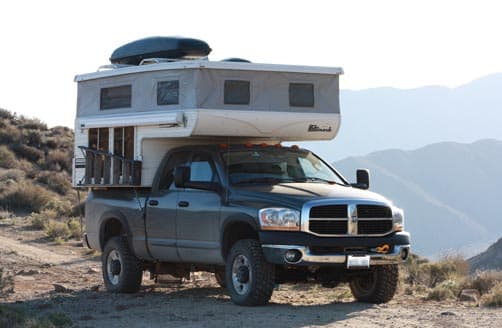
The relative size of truck campers compared to motorhomes and fifth-wheels works both for and against you. The “for” you know about – the go anywhere, camp anywhere, tow anything part. The “against” part is mostly about capacities – potable (drinking) water, gray water, black water, and batteries.
You can boondock with any truck camper you have. The question is: for how long and in what degree of comfort? If your lifestyle includes long, full-flow hot showers, hours of watching TV, running the air-conditioning, an electric blanket, and microwave oven, you will have to make more severe changes than those already leaning toward a more minimalist lifestyle.
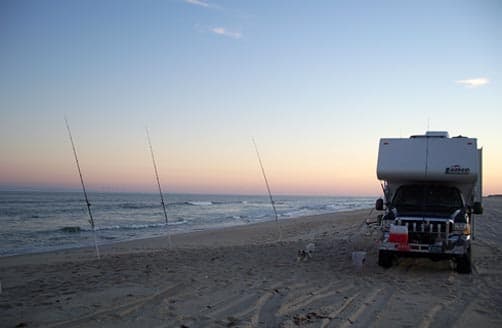
But you don’t have to live like a Tibetan monk to boondock with your camper either. You just have to make some adjustments, decide which features are important to you, and which aren’t and then do some tweaking.
As you gain experience, you will balance the factors that limit the number of consecutive days you can boondock with your desired comfort level. Mostly, it’s a matter of changing habits.
Water: Nectar from the Gods
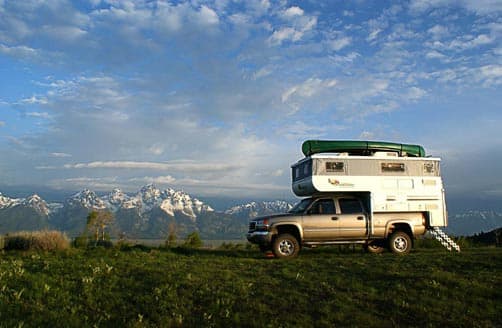
Being conservative in your use of fresh water will not only allow you to boondock longer, but will also slow the filling of your gray water tank (from shower and sink use). But you can also extend your fresh water capacity by carrying full jerry jugs or collapsible bladders that can be emptied into your fresh water tank. The jugs you can then lash to your roof out of the way and the bladders will fold flat and stow in minimal space.
But, if you add water to your initial fresh water capacity, then you will add waste water to your gray tank unless you do something else with it. For instance, a plastic dishpan in your shower will capture the water that you run while warming it up. Then use that water for dishwashing and rinsing or flushing the toilet.
You can also buy a dump cap with a hose fitting, attach a garden hose, and direct your gray water off to a thirsty bush. If you’re going to do this, make sure you use biodegradable soaps and scrape off all food bits before allowing the water to enter your gray tank. Dish and rinse water collected in a dishpan can be dumped directly on plants or in a freshly dug hole.
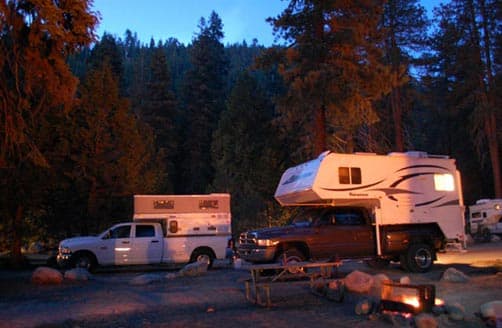
A solar shower, a black vinyl bag of about five or six gallon capacity with a length of plastic tubing with a shower nozzle attached, when laid out in the sun for several hours will heat the water inside to shower temperature. The solar shower serves as an extra water supply and can be filled from a stream or lake, saving your on board supply.
The Black Water Tank
Your black water holding tank (from the toilet) will fill less rapidly than your gray water tank providing you don’t flush with gallons of water like your home toilet. But when it fills, your only option is to pack up and find the nearest dump station. Never dump your black tank on the ground. For this reason, a sizable black water tank is preferable if you intend to boondock for extended periods.
Some truck campers offer a cassette toilet, a built in toilet with a removable waste tank that is accessed via an outside compartment door. Cassette toilets can be dumped into any residential style toilet, pit toilet, or dump station. A cassette toilet can significantly increase your boondocking time if you can periodically access a toilet. An even more basic boondocking alternative would be a Porta-Potti, essentially a smaller capacity cassette toilet that doesn’t require permanent installation. Like the cassette toilet, a Porta-Potti can be dumped into any toilet.
Electric: DC and AC
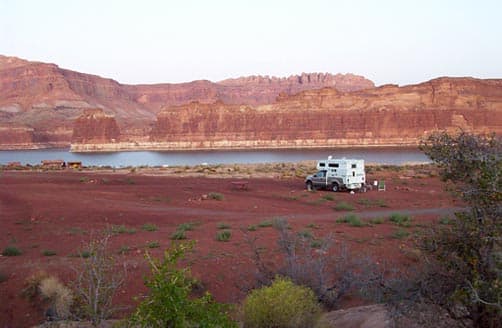
When you are hooked up to shore power, you have both 12-volt and 120-volt power available to you through the systems wired into your camper. When you are boondocking off-the-grid, you have only 12-volt unless you run a generator or have an inverter. More on this later.
Without shore power or an on-board 120-volt system, you lose the ability to use the air-conditioner, microwave, or any AC appliances you have onboard including residential coffee makers, computers, and battery chargers for your cell phone and other battery-operated devices. If it needs to be plugged in at home, it won’t work without a 120-volt system.
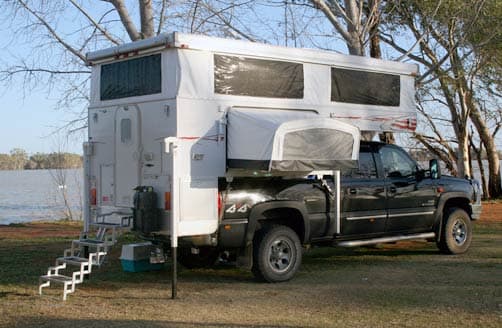
What you can operate on 12-volt is your water pump (for the shower, sinks, toilet flushing), interior lights, and any 12-volt electronics such as an automotive style AM/FM stereo or 12-volt television. How long you can use these 12-volt features before your camper battery goes belly up is dependent on how much you use them.
The limits of battery life means you have to be conscious about conserving electrical energy. Turn off appliances or lights if they are not in use. Don’t turn on two lights if one will do. Use battery-operated book lights for reading rather than the camper lights. Turn the shower off between sudsing up and rinsing off to save the water pump from using electricity, to conserve fresh water, and limit use of the gray water tank.
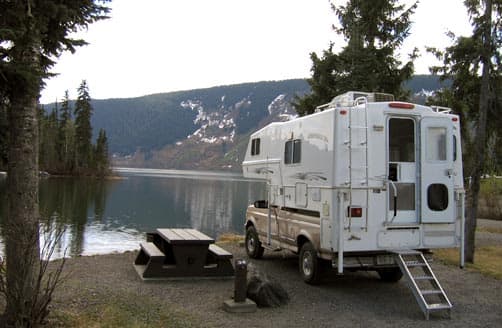
You can double your electrical capacity by installing a second camper battery, or two six-volt golf cart batteries. You can use a portable or built-in generator to charge low batteries, but the noise of a running generator can be annoying and it can take hours for batteries to charge. The upside is that you can operate your AC and high amperage DC appliances off the generator, thereby reducing the drain from your batteries. Need to run the microwave for a couple minutes? Fire up the generator, and then turn it off.
You can also run your truck engine to recharge low batteries, but again, it can take hours to recharge dead batteries. If you have an inverter, which changes 12-volt power into 120-volt, you can run your AC appliances, but the AC will suck ten times as much electrical energy out of your batteries as DC powered appliances. Your best bet is to keep to 12-volt appliances and use them as sparingly as possible.
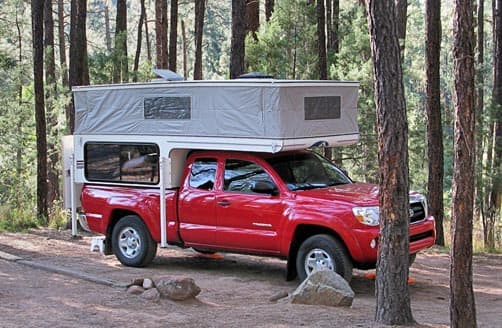
Solar power is perfect for boondocking. When the sun is shining, solar power charges your batteries all day long with no moving parts, no maintenance, and no noise. Unfortunately, solar is also expensive to buy, though it provides your electricity free forever after.
The trick is figuring out what size solar system you need. Several online solar websites provide worksheets for this purpose, including www.amsolar.com, a company that specializes in RV solar systems. What you need to do is calculate your electrical needs by appliance; amperage draw times the number of hours used per day. Add up these electricity needs and match that figure with the panel size required to produce that amount of electricity each day with a cushion added to compensate for heavier usage or cloudy days when the rate of charge is lower.
Propane
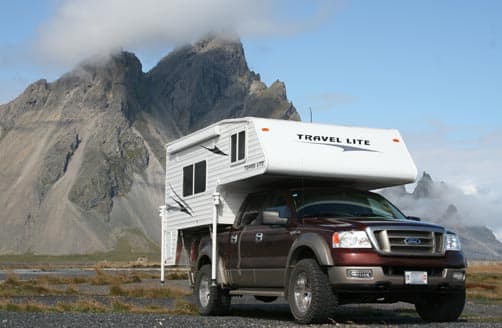
Another system you have built-in to most truck campers is a liquid propane gas (LP) system. Propane will operate your refrigerator when your camper is not hooked up and running on 120-volt shore power. Propane will also run your heater, cook top, oven, and water heater. Propane is not usually a limiting factor since two full tanks will usually last two weeks or more in normal usage. Just don’t forget to check it before you head out to boondock. And if you’re boondocking in cold weather, you will use propane much faster as you heat your rig.
A good addition to campers that have forced air heating, which is very inefficient and will rapidly deplete your battery, is the addition of a catalytic heater such as the Olympian Wave series sold by RV and marine supply stores. These heaters, which operate by chemical action and use no electricity, come in many sizes and cost only a few pennies worth of propane per hour to operate. When using a catalytic heater, or any propane appliance for that matter, it’s critically important to have as last one window cracked open for ventilation.
So go ahead. Turn off onto that dirt road that leads who-knows-where. Boondocking, like life, is a continual learning experience. Enjoy the journey.
